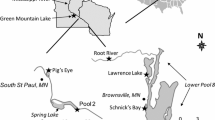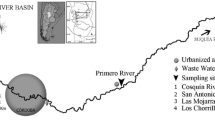Abstract
Cliff swallows (Petrochelidon pyrrhonota) and cave swallows (P. fulva) were sampled during the breeding season at several locations in the Rio Grande, Texas, to evaluate the potential effects of environmental contaminants on P450 aromatase activity in brain and gonads and DNA damage in blood cells. The tritiated water-release aromatase assay was used to measure aromatase activity and flow cytometry was used to measure DNA damage in nucleated blood cells. There were no significant differences in brain and gonadal aromatase activities or in estimates of DNA damage (HPCV values) among cave swallow colonies from the Lower Rio Grande Valley (LRGV) and Somerville. However, both brain and gonadal aromatase activities were significantly higher (P < 0.05) in male cliff swallows from Laredo than in those from Somerville. Also, DNA damage estimates were significantly higher (P < 0.05) in cliff swallows (males and females combined) from Laredo than in those from Somerville. Contaminants of current high use in the LRGV, such as atrazine, and some of the highly persistent organochlorines, such as toxaphene and DDE, could be potentially associated with modulation of aromatase activity in avian tissues. Previous studies have indicated possible DNA damage in cliff swallows. We did not observe any differences in aromatase activity or DNA damage in cave swallows that could be associated with contaminant exposure. Also, the differences in aromatase activity and DNA damage between male cliff swallows from Laredo and Somerville could not be explained by contaminants measured at each site in previous studies. Our study provides baseline information on brain and gonadal aromatase activity in swallows that could be useful in future studies.
Similar content being viewed by others
References
Ankley G, Mihaich E, Stahl R, Tillitt D, Colborn T, McMaster S, Miller R, Bantle J, Campbell P, Denslow N, Dickerson R, Folmar L, Fry M, Giesy J, Gray LE, Guiney P, Hutchinson T, Kennedy S, Kramer V, LeBlanc G, Mayes M, Nimrod A, Patino R, Peterson R, Purdy R, Ringer R, Thomas P, Touart L, van der Kraak G, Zacharewski (1998) Overview of a workshop on screening methods for detecting potential (anti-) estrogenic/androgenic chemicals in wildlife. Environ Toxicol Chem 17:68–87
Armstrong DG (1984) Ovarian aromatase activity in the domestic fowl (Gallus domesticus). J Endocrinol 100:81–86
Bickham JW (1990) Flow cytometry as a technique to monitor the effects of environmental genotoxins on wildlife populations. In: Sandhu SS, Lower WR, de Serres FJ, Suk WA, Tice RR (eds) In situ evaluations of biological hazards of environmental pollutants. Plenum Press, New York, pp 97–108
Bickham JW, Mazet JA, Blake J, Smolen MJ, Lou Y, Ballachey BE (1998) Flow cytometric determination of genotoxic effects of exposure to petroleum in mink and sea otters. Ecotoxicology 7:191–199
Bickham JW, Sandhu S, Herbert PDN, Chikhi L, Athwal R (2000) Effects of chemical contaminants on genetic diversity in natural populations: implications for biomonitoring and ecotoxicology. Mutat Res 463:33–51
Bolognesi C, Landini E, Roggieri P, Fabbri R, Viarengo A (1999) Genotoxicity biomarkers in the assessment of heavy metal effects in mussels: experimental studies. Environ Mol Mutagen 33:287–292
Bradford MM (1976) A rapid and sensitive method for the quantitation of microgram quantities of protein utilizing the principle of protein-dye binding. Anal Biochem 72:248–254
Brown CR, Brown MB (1995) Cliff swallow. In: Poole A, Gill F (eds) The birds of North America. No. 149. The academy of natural sciences. Philadelphia and The American Ornithologists’ Union, Washington, DC
Bruggeman V, As PV, Decuypere E (2002) Developmental endocrinology of the reproductive axis in the chicken embryo. Comp Biochem Physiol A 131:839–846
Codina JC, Cazorla FM, Pérez-García A, Vicente de A (2000) Heavy metal toxicity and genotoxicity in water and sewage determined by microbiological methods. Environ Toxicol Chem 19:1552–1558
Colborn T, vom Saal FS, Soto AM (1993) Developmental effects of endocrine-disrupting chemicals in wildlife and humans. Environ Health Perspect 101:378–384
Conley A, Hinshelwood M (2001) Mammalian aromatases. Reproduction 121:685–695
Elbrecht A, Smith R (1992) Aromatase enzyme activity and sex determination in chickens. Science 255:467–470
Gaunt AS, Oring LW (Eds) (1997) Guidelines to the use of wild birds in research. The Ornithological Council, Washington, DC
Guillette LJ Jr, Gross TS, Masson GR, Matter JM, Percival HF, Woodward AR (1994) Developmental abnormalities of the gonad and abnormal sex hormone concentrations in juvenile alligators from contaminated and control lakes in Florida. Environ Health Perspect 102:680–688
Hayes T, Haston K, Tsui M, Hoang A, Haeffele C, Vonk A (2003) Atrazine-induced hermaphroditism at 0.1 ppb in American leopard frogs (Rana pipiens): laboratory and field evidence. Environ Health Perspect 111:568–575
Huggett DB, Foran CM, Brooks BW, Weston J, Peterson B, Marsh KE, La Point TW, Schlenk D (2003) Comparison of in Vitro and in Vivo bioassays for estrogenicity in effluent from North American municipal wastewater facilities. Toxicol Sci 72:77–83
International Boundary Water Commission (IBWC) (1998) Second phase of the binational study regarding the presence of toxic substances in the Rio Grande/Rio Bravo and its tributaries along the boundary portion between the United States and Mexico. Final report. IBWC, El Paso, Texas
Jobling S, Nolan M, Tyler CR, Brighty G, Sumpter JP (1998) Widespread sexual disruption in wild fish. Environ Sci Technol 32:2498–2506
Laville N, Balaguer P, Brion F, Hinfray N, Casellas C, Porcher J-M, Aït-Aïssa S (2006) Modulation of aromatase activity and mRNA by various selected pesticides in the human choriocarcinoma JEG-3 cell line. Toxicology 228:98–108
Lephart ED (1996) A review of brain aromatase cytochrome P450. Brain Res Rev 22:1–26
Lephart ED, Simpson E (1991) Assay of aromatase activity. Method Enzymol 206:477–483
Maruya KA, Smalling KL, Mora MA (2005) Residues of toxaphene in insectivorous birds (Petrochelidon spp.) from the Rio Grande, Texas. Arch Environ Contam Toxicol 48:567–574
Matson CW, Palatnikov GM, McDonald TJ, Autenrieth RL, Donnelly KC, Anderson TA, Canas JE, Islamzadeh A, Bickham JW (2005) Patterns of genotoxicity and contaminant exposure: evidence of genomic instability in the marsh frogs (Rana ridibunda) of Sumgayit, Azerbaijan. Environ Toxicol Chem 24:2055–2064
McPhaul MJ, Noble JF, Simpson ER, Mendelson CR, Wilson JD (1988) The expression of a functional cDNA encoding the chicken cytochrome P-450arom (aromatase) that catalyzes the formation of estrogen from androgen. J Biol Chem 263:16358–16363
Mora MA, Wainwright SE (1998) DDE, mercury, and selenium in biota, sediments, and water of the Rio Grande-Rio Bravo Basin, 1965–1995. Rev Environ Contam Toxicol 158:1–52
Mora MA, Boutton TW, Musquiz D (2005) Regional variation and relationships between the contaminants DDE and selenium and stable isotopes in swallows nesting along the Rio Grande and one reference site, Texas, USA. Isotopes Environ Health Stud 41:1–17
Mora MA, Musquiz D, Bickham JW, Mackenzie DS, Hooper MJ, Szabo JK, Matson CW (2006) Biomarkers of exposure and effects of environmental contaminants on swallows nesting along the Rio Grande, Texas, USA. Environ Toxicol Chem 25:1574–1584
Nitta H, Osawa Y, Bahr JM (1991) Immunolocalization of steroidogenic cells in small follicles of the chicken ovary: anatomical arrangement and location of steroidogenic cells change during follicular development. Domest Anim Endocrin 8:587–594
O’Donnell L, Robertson KM, Jones ME, Simpson ER (2001) Estrogen and spermatogenesis. Endocr Rev 22:289–318
Reeder AL, Ruiz MO, Pessier A, Brown LE, Levengood JM, Phillips CA, Wheeler MB, Warner RE, Beasley VR (2005) Intersexuality and the cricket frog decline: historic and geographic trends. Environ Health Perspect 113:261–265
Sanderson T, van den Berg M (2003) Interactions of xenobiotics with the steroid hormone biosynthesis pathway. Pure Appl Chem 75:1957–1971
Sanderson JT, Letcher RJ, Heneweer M, Giesy JP, van den Berg M (2001) Effects of chloro-s-triazine herbicides and metabolites on aromatase activity in various human cell lines and on vitellogenin production in male carp hepatocytes. Environ Health Perspect 109:1027–1031
Schlinger BA, Callard CV (1989) Aromatase activity in quail brain: correlation with aggressiveness. Endocrinology 124(1):437–443
Shugart L, Bickham J, Jackim G, McMahon G, Ridley W, Stein J, Steinert S (1992) DNA alterations. In: Huggett RJ, Kimerle RA, Mehrle PM, Bergman HL (eds) Biomarkers: biochemical physiological and histological markers of anthropogenic stress. Lewis Publishers, Boca Raton, FL, pp 125–153
Simpson ER, Mahendroo MS, Means GD, Kilgore MW, Hinshelwood MM, Graham-Lorence S, Amarneh B, Ito Y, Fisher CR, Michael MD, Mendelson CR, Bulun SE (1994) Aromatase cytochrome P450, the enzyme responsible for estrogen biosynthesis. Endocr Rev 15:342–355
Simpson ER, Clyne C, Rubin G, Boon WC, Robertson K, Britt K, Speed C, Jones M (2002) Aromatase-a brief review. Annu Rev Physiol 64:93–127
Texas Natural Resource Conservation Commission (TNRCC) (2002) State of the Rio Grande and the environment of the border region. Strategic plan fiscal years 2003–2007, vol 3. TNRCC, Austin, Texas
Tsuzuki K, Sugiyama M, Haramaki N (1994) DNA single-strand breaks and cytotoxicity Induced by chromate(VI), cadmium(II), and mercury(II) in hydrogen peroxide-resistant cell lines. Environ Health Perspect 102(Suppl 3):341–342
United States Department of Agriculture (USDA) (2006) Agricultural chemical usage 2005 fields crops summary. USDA National Agricultural Statistics Service, pp 1–167
Unites States Environmental Protection Agency (USEPA) (nd) Envirofacts data warehouse and toxics release inventory (TRI). Retrieved February 11, 2005 from Envirofacts Data Warehouse http://www.epa.gov/enviro/html/tris/tris_query.html
Varady R, Romero-Lankao P, Hankins KB (2001) Managing hazardous materials along the US-Mexico border. Environ 43:22–36
Vindelov LL, Christiansen IJ (1994) Detergent and proteolytic enzyme-based techniques for nuclear isolation and DNA content analysis. In: Darzynkiewicz Z, Robinson JP, Crissman HA (eds) Flow cytometry: methods in cell biology, Part A, 2nd edn. Academic Press, New York, pp 29–229
West S (1995) Cave swallow. In: Poole A, Gill F (eds) The birds of North America. No. 141. The academy of natural sciences. Philadelphia and The American Ornithologists’ Union, Washington, DC
Yang C, Chen S (1999) Two organochlorine pesticides, toxaphene and chlordane, are antagonists for estrogen-related receptor α-1 orphan receptor. Cancer Res 59:4519–4524
You L, Sar M, Bartolucci E, Ploch S, Whitt M (2001) Induction of hepatic aromatase by p, p’-DDE in adult male rats. Mol Cell Endocrinol 178:207–214
Younglai EV, Holloway AC, Lim GE, Foster WG (2004) Synergistic effects between FSH and 1, 1-dichloro-2, 2-bis(P-chlorophenyl)ethylene (P, P’-DDE) on human granulosa cell aromatase activity. Hum Reprod 19:1089–1093
Zala SM, Penn DJ (2004) Abnormal behaviours induced by chemical pollution: a review of the evidence and new challenges. Anim Behav 68:649–664
Author information
Authors and Affiliations
Corresponding author
Rights and permissions
About this article
Cite this article
Sitzlar, M.A., Mora, M.A., Fleming, J.G.W. et al. Potential effects of environmental contaminants on P450 aromatase activity and DNA damage in swallows from the Rio Grande and Somerville, Texas. Ecotoxicology 18, 15–21 (2009). https://doi.org/10.1007/s10646-008-0251-8
Received:
Accepted:
Published:
Issue Date:
DOI: https://doi.org/10.1007/s10646-008-0251-8




